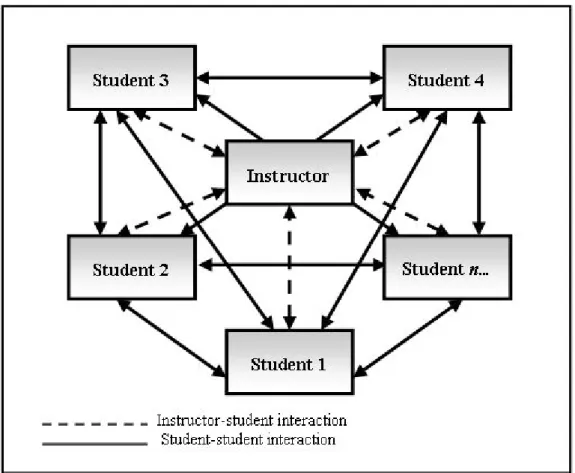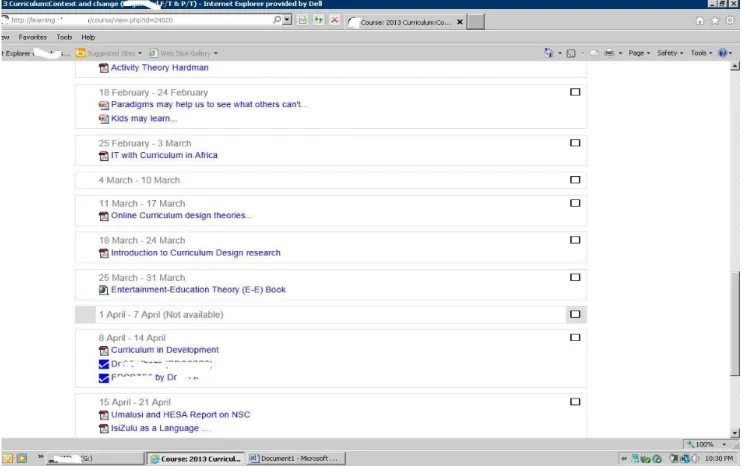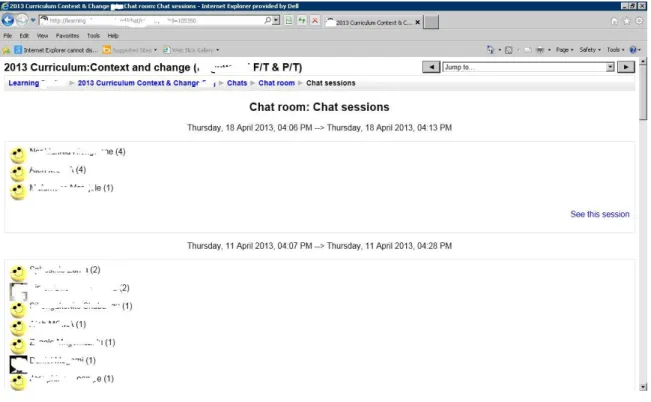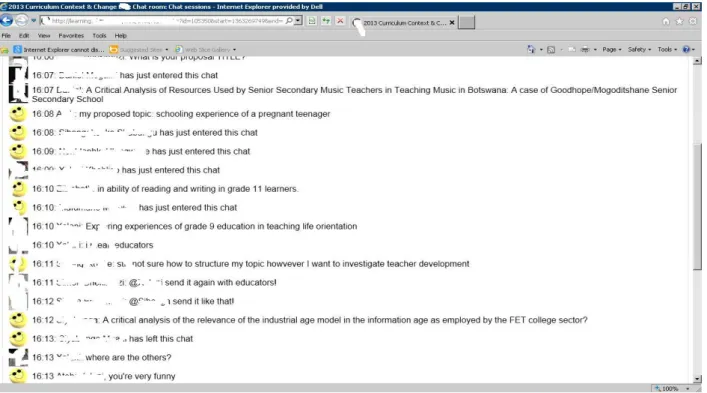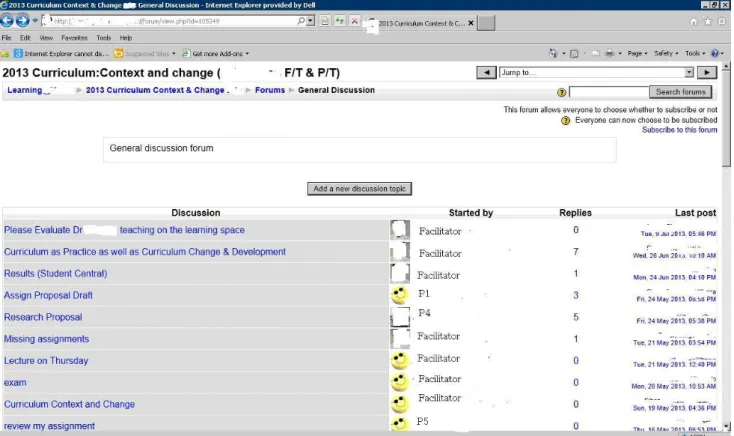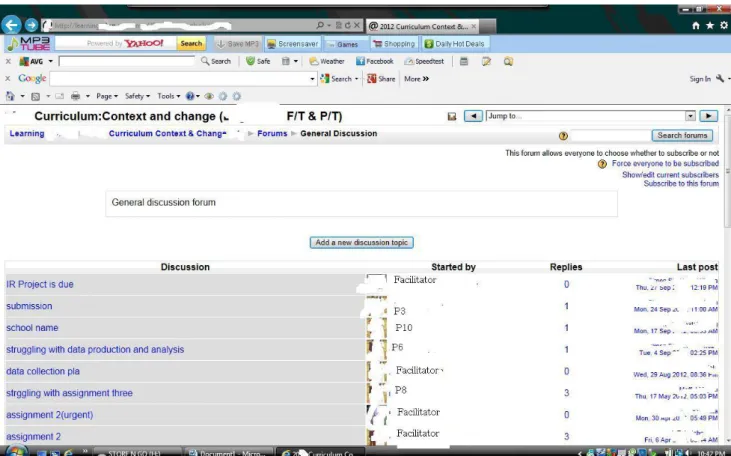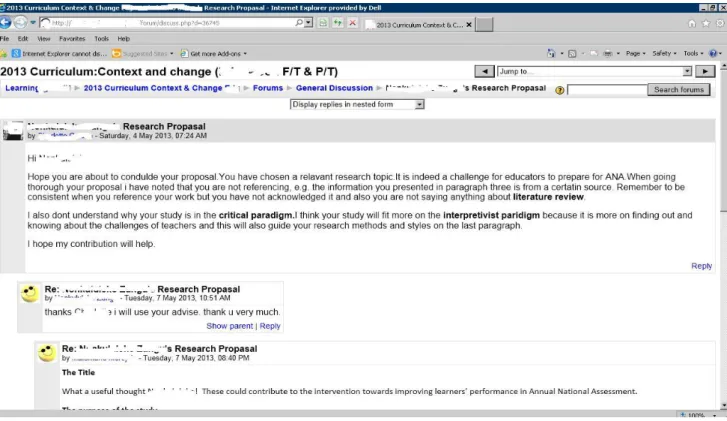The purpose of this study evaluated the use of online resources in teaching and learning the Curriculum Context and Change module at a university in Durban, South Africa. The findings showed that there were potentially more benefits than challenges in using online resources in teaching and learning the module.
Introduction 1
Background 1
Motivation of the Study 2
Objectives of the Study 2
Identify and explain which online resources are used by facilitators and students in the Curriculum Context and Change module. Explore the reasons why the uses of online resources are implemented in this way in the Curriculum Context and Change module.
Research Questions 2
Concepts 3
Research Paradigm 3
The interpretive paradigm is important for this study because it explored the experiences of lecturers and students, which differed from each other, but definitely added their own unique response to the study.
Literature Review 4
What online resources are used by facilitators and students in teaching/
Bonk (2001) discovered that 74% of study participants expressed links to e-journals in their teaching. In a study outlined by Burke, Snyder and Rager (2009), almost half of the respondents involved in the research revealed the use of YouTube in their courses.
Theoretical Framework 8
The purpose of this study explored the use of online resources in the teaching and learning of the context and curriculum change module using the theoretical framework of Cultural Historical Activity Theory (CHAT) or Activity Theory (AT) in providing an analysis. The scope refers to the use of online resources in the teaching and learning of the Context and Curriculum Change module.
Research Design and Methodology 11
Qualitative Field of Research 11
Case Study 11
This study uses an online questionnaire, observation and semi-structured interviews to define and validate the case study in question. Thus, case studies follow the process and outcome of a phenomenon through the case under investigation.
Context and Sampling 12
By comparing this study with the concerns expressed in the literature review (such as the lack of assimilation with online resources as a teaching methodology, untrained and inexperienced facilitators and poor online technical support experienced in previous years) it was possible to determine whether the educational institution, facilitator and students progressed in this present study. Although case studies are often criticized for their lack of generalizable findings beyond the sample group, the detailed qualitative accounts help to explore or describe the data in real settings (Zainal, 2007).
Validity, Reliability and Trustworthiness Issues 12
In a research study, there are several types of validity that can be sought to determine the truth of the research. When describing trustworthiness in qualitative research, the terms trustworthiness, neutrality, confirmability, reliability, applicability and transferability can replace questions of reliability and validity in evaluating the quality of research (Golafshani, 2003).
Methods of Data Generation 13
- Document Analysis 13
- Online Questionnaire 14
- Observation 14
- Semi-structured Interviews 14
The researcher believed that all data collection procedures should be transparent to ensure the validity of the findings. This assisted the researcher in determining the experiences of the facilitator and students in using online resources in the Context and Curriculum Change module.
Data Production / Generation 15
The study under review used at least one semi-structured interview style with one facilitator and eleven students in a focus group. It is often preceded by observation, informal and unstructured interviewing about the topic of interest, which then generates appropriate semi-structured questions (Cohen, 2006).
Data Analysis 15
Of the thirty-five students, five were selected for at least one one-on-one interview. Next, the interviewer and participants engage in a formal interview using an interview guide developed by the researcher.
Ethical Issues 15
Limitations of the Study 16
Structure and Direction of the Study 16
Analysis and interpretation of the data from interviews, observations, document/learning space analysis and the online reflections are involved in this process. Interestingly, as a result of the findings, the researcher developed an online/e-learning framework that is used to support the research and is presented in the form of a recommendation.
Conclusion 17
Chapter six concludes the entire study by recreating the methodology used to answer the research questions, explaining the significance of the study and providing a summary of the findings. Finally, the conclusion presents a holistic description of the findings from the data generation methods by suggesting the potential benefits the use of online resources has for facilitators and students in similar contexts.
Introduction 18
Technological Developments that Affect Education 18
Since knowledge can be gained at a rapid pace, the use of technological advances in education is inevitable. Therefore, it is imperative to see the role of government in creating online learning in education through technological innovations.
The Role of Government in Advocating a Tech-Savvy Generation 19
In Wales, e-learning is enshrined in the policy objectives of the National Assembly as set out in the 2001 publication 'The Learning Country' (Smith & Jones, 2004). According to Czerniewicz et al (2006) there is no overarching policy set out for the use of ICT in higher education in South Africa.
The Impact of Technology: A Digital Divide? 22
Conversely, TOE is demonstrated by any teaching and learning tool that you cannot see or touch. WBTL must include all three means to make and, in essence, achieve effective teaching and learning.
The Experience of Digital Immigrants Globally 26
The facilitator's objective (subject) was to use online tools in conjunction with the face-to-face strategy to learn about curriculum policy, change and practice (objective) so that students could gain enough knowledge from this to successfully complete their assessment tasks. results). How facilitators and students use online resources in the teaching and learning of the context and curriculum change module.
Higher Education and Online World 28
- Discussion Forum 29
- Search Engines 33
- Chat Room 36
- Web 2.0 38
Potential Use and Possible Limitations of Implementing an Online
Advantages of Online Teaching and Learning 49
Disadvantages of Online Teaching and Learning 49
Conclusion 50
The literature has provided a description of the use of online resources in teaching and learning in higher education institutions, in the context of developing and developed countries internationally. A review of the literature in the previous chapter regarding the use of online resources as a tool for teaching and learning within higher education institutions showed the potential use of online tools and the potential limitations that exist.
Research Paradigm 52
The Interpretive Paradigm 53
Yet Christainsen et al, (2010) argue that the principle of the interpretive paradigm is not to generalize the findings, but specifically to make sense of people's experience through their personal interactions. The interpretive paradigm also makes the researcher as the primary data collection instrument by using constructed questions focused on understanding phenomena through interviews and observation in their settings (Denzin & Lincoln, 2003).
Background to Learning Theories 54
The dawn of the 20th century propelled the theory of behaviorism as a dominant paradigm for investigating learning. Although modern learning theories are repugnant to the nature of the condition itself, behaviourist learning theory has been relevant in guiding the development of sequenced and structured curricula (Mergel, 1998).
Activity Theory / Cultural Historical Activity Theory 57
- Historical Insight to the Development of Activity Theory 57
- Activity Theory in Essence 58
- Characterising Cultural Historical Activity Theory 59
- Subject 60
- Tools / Resources 61
- Object 62
- Community 64
- Division of Labour 66
- Rules 69
- Outcomes 71
- A Model of the Activity System Structure 73
Therefore the researcher has identified the facilitator and the students of the Context and Curriculum Change module as subjects in the activity system of this study. The motive includes the object of the activity and the outcome is continuous (Kain & Wardle, 2008).
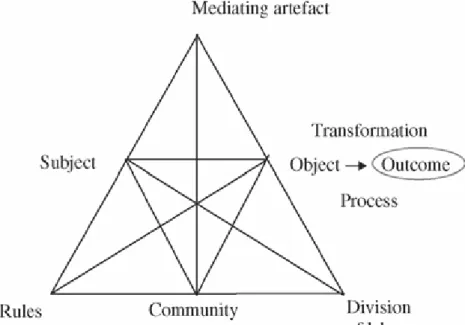
Activity Theory in Online Contexts at Higher Education 74
To further complement this discussion, activity theory is also envisioned as a means of investigating phenomena in different ways. It appears from the various studies that activity theory has considerable potential when used as a theoretical framework to investigate teaching and learning in online contexts.
Conclusion 76
This further empowers the researcher by providing him with a deeper analysis of the findings emerging from this current research, and by giving him the opportunity to explain these in the rationale of activity theory. Activity theory was initially developed by Vygotsky (1978), and later extended by Leontev (1981) and Engeström (1999) to inform technological learning environments.
Research Design and Methodology 77
Research Design 78
The quality of any research study can be improved by a thorough understanding of the research design. The interpretive research design was considered integrated as it took into account the collection of qualitative information, observation of the facilitator and students in relation to the lectures that took place, and conversation with participants through interviews (Wahyuni, 2012).
Qualitative Case Study Methodology 79
It is a research design that focuses on a single case – the implementation of online resources as a teaching and learning tool by the facilitator and course students. What online resources are being used by facilitators and students in teaching and learning the Context and Curriculum Change module?” Documents were analyzed through the online learning space in order to identify online tools used for teaching and learning.
Qualitative Approach 83
Multiple Methods of Generating Data 86
The researcher used multiple methods and data sources during the research process in this study. The researcher can generate and integrate the data, creating a holistic understanding of the phenomenon under investigation (Baxter & Jack, 2008).
Research Setting and Sampling 87
Purposive Sampling 88
With this reasoning in mind, the researcher has chosen a mediator who leads the course and the thirty-five students who are part of it. Purposive sampling is often done by convenience sampling, which suggests that the researcher choose a sample that is easy to reach.
The Context 89
The University 89
The university's multicultural ethos hosts both local and international students. It is now appropriate to describe the course placed in the context of the university.
The Curriculum Context and Change Module 90
This is done by addressing predetermined research objectives and questions (Savenye & Robinson, 2004). The study used a semi-structured interview style. Facilitator: “The online resources of this university library and other campuses are mainly used by facilitators and students.
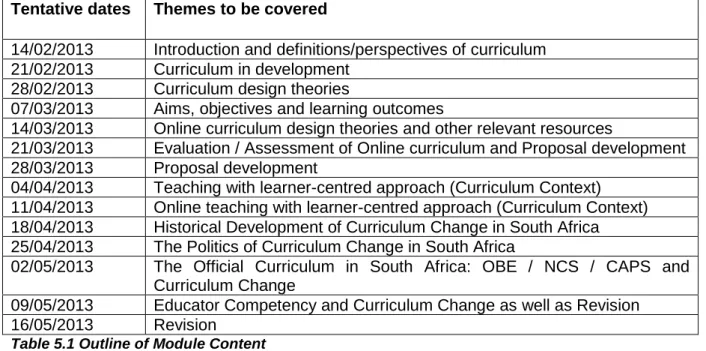
Data Generation Methods 92
Observation 92
Advantages of Observation 93
Limitations of Observation 93
The Process of Observation 94
Focus Group 97
Advantages of Conducting Focus Groups 98
Limitations of Conducting Focus Groups 98
Semi-structured Interviews 99
Advantages of Conducting Semi-structured Interviews 99
Limitations of Conducting Semi-structured Interviews 100
The Process of Collecting Data Using Interviews 100
Online Reflection 102
Advantages of Online Reflection 103
Limitations of Online Reflection 103
Document Analysis / Learning Space Analysis 103
Piloting 104
Data Analysis 105
Credibility / Trustworthiness / Crystallization 105
Ethical Considerations 108
Conclusion 109
Introduction 111
P10: “The content broadened my thinking, especially as a secondary school teacher, because it helped me better understand the changes in the curriculum in South Africa, so that this can help me develop as a teacher and thereby [help] my students”. What online resources do facilitators and students use in teaching and learning the Context and Curriculum Change module.
Qualitative Data Analysis 112
Data Presentation 112
Theme One: Subject 113
- Profiles of Participants 114
In this sense, there was close interaction with the participants in the Curriculum Context and Change module when generating data. The participants in the study consisted of five students and one facilitator of the Curriculum Context and Change module.
Theme Two: Object 119
Based on these perceptions, the researcher identified the content of the module as the subject of this study. These comments indicate that the content of the module was appropriate because the learning outcomes included that students should be able to determine curriculum change.
Theme Three: Tools/Resources 123
- Hard-Ware (HW) 124
- Soft-Ware (SW) 128
- Ideological-Ware (IW) 147
The above figure 5.5 represents a discussion forum on the learning space of the Curriculum Context and Change module. The facilitator indicated that it was important for students to learn about activity theory as this contributed to their understanding of the module.
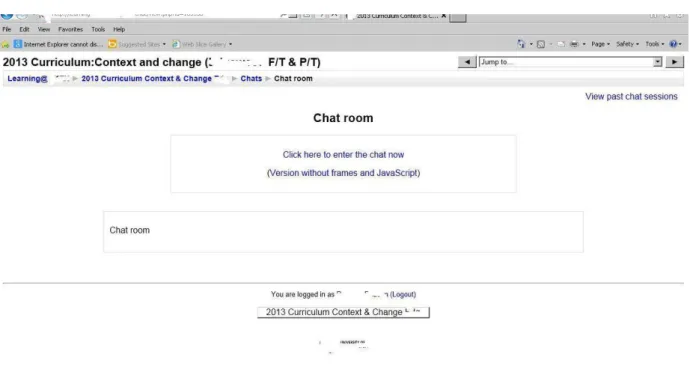
Theme Four: Outcomes / Aims and Objectives 154
The module contained eight specific learning outcomes that students were expected to achieve by the end of the module. Significantly, the facilitator was constantly aware of the learning outcomes and therefore guided them in the lectures.
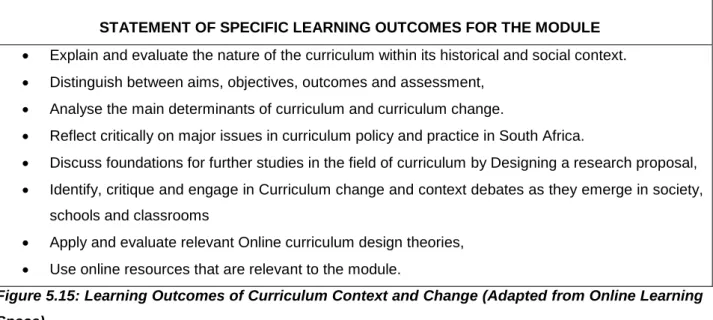
Theme Five: Rules 157
- Assessment 157
- Engagement with Prescribed Readings 158
- Attendance 159
- Implications for Attainment of Goals 159
The summative assessment of the module was twofold; consisting of a classroom presentation and written assignments. The above is just a sample of some of the prescribed readings that were accessible online through the learning space and search engines.
Theme Six: Community 159
Therefore, community members include technicians, peer students, examiners, conference presenters and researchers within the curriculum, the academic cluster of Curriculum Studies and the researcher. Censors were influential in the role of community because they mark all students' projects according to the facilitator's grades.
Theme Seven: Division of Labour 162
This suggested that they needed each other because without an online learning environment, technical staff might not be needed; if students do not successfully complete their projects using fast and reliable online resources, external assessors will not be able to assess and peers will not have much support; conference seminars will not attract as many students; and the researcher will not have a research paper to investigate. Therefore, it is essential to consider the role of division of labor in the activity system in order to create an effective environment for teaching and learning.
Analysis and Interpretation of Findings 163
Implications for Improving Practise as Educators 168
All participants indicated that they prefer using an online platform as it is the way forward in the current nature of education within the global context. The participants' hopes and ambitions as educators lean towards the use of online tools in teaching and learning in schools to prepare their students for tertiary institutions and the world of the job market as the way forward in a competitive market.
Key Findings of the Study 168
However, due to insufficient finance, infrastructure and training to operate in such environments, some students were concerned whether this would become a reality in the near future. Students used SW (online resources) more than HW (library, books) because they were fast, easy to use and accessible from home and workplace.
Conclusion 169
In the initial phase of the module, the facilitator used a teacher-centered approach to introduce students to online tools and guide them through their learning process. Significantly, as a result of the findings that emerged, the researcher developed a framework to support the assumptions regarding the use of online resources in the module, known as the online/e-learning framework.
Methodology 171
The research undertaken sought to identify and explain facilitator and student experience in using online resources to explore policy, practice and curriculum change. Facilitators should therefore be careful how they implement online resources in the teaching and learning context so that learning is about the theories and principles that the module is trying to articulate, rather than the technological devices used to taught.
Significance of the Study 172
Therefore, the use of online resources helped in achieving the intended objectives (outcomes) of the module. Without this tool, they could not meet the learning outcomes of the module.
Summary of Major Findings 174
Subject 174
The researcher examined their experiences with using online resources in line with the claims made by the literature review. In addition, the facilitator's attributes, such as educational technology qualifications and experience, informed the researcher of the importance this has in managing online teaching and learning contexts.
Object 174
Essentially, the subjects conveyed their particular beliefs, values and assumptions that brought a different story to the activity system, and it is within this spectrum that the researcher has determined how the subject is related to other components of the activity system (Thuraisingam et al, 2012). With this in mind, the facilitator was careful to prioritize the goals of the content over the technology.
Tools / Resources 175
This is a symbol of IW resources that are integral in providing strong support for the use of HW and SW resources. Therefore, DAU was encouraged by powerful IW resources, with combined HW and SW to achieve the intended learning outcomes of the module.
Outcomes / Aims and Objectives 176
As a result of the online learning space, students could talk to each other at different times from their PCs/Laptops. This led to greater student participation, which influenced their understanding of the module when completing assignments.
Rules 177
The learning outcomes of the module included an analysis of curricular policy, practice and change; engaging with web design theories that supported the use of the online learning platform; and discussion of curriculum in a progressive society, among others. He achieved this because he completed the module content on time, used a range of learning resources (online and offline) and evaluated all assignments on time.
Community 178
For face-to-face students, attendance was mandatory to ensure they were part of the class discussions and could complete the PowerPoint presentations that were part of their assessment.
Division of Labour 179
Address of the Research Questions 179
- What online resources are being used by the facilitator and students
- How were online resources used by the facilitator and students
- Why were online resources being used by the facilitator and students
- Discussion of Findings 183
The computer was used to access the online learning space in which the facilitator and students could engage with the online tools. Consequently, the study answered the what, how and why online resources are used in the teaching and learning of the Curriculum Context and Change module.
Recommendations 184
Online / E-Learning Resources Framework 184
- Principle of Wanted Resources (Hard - Ware) 185
- Principle of Needed Resources (Soft-ware – SW) 185
- Principle of Demanded Resources (Ideological-ware – IW) 185
- Implications for the Study 186
Interestingly, the data generated further indicates that certain resources such as Turnitin, discussion forum and IW resources were considered mandatory to use by the module, motivated by the university. This is an integral assumption that can be supported by the following framework developed by the researcher and which is worth interrogating to some extent.
Improving the Chat Room Tool as a Valuable Resource 186
Conclusion 187
